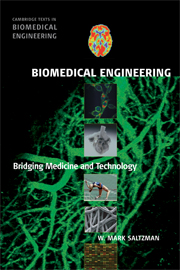Book contents
- Frontmatter
- Contents
- Preface
- Acknowledgments
- Abbreviations and Acronyms
- 1 Introduction: What Is Biomedical Engineering?
- PART 1 MOLECULAR AND CELLULAR PRINCIPLES
- PART 2 PHYSIOLOGICAL PRINCIPLES
- 6 Communication Systems in the Body
- 7 Engineering Balances: Respiration and Digestion
- 8 Circulation
- 9 Removal of Molecules from the Body
- PART 3 BIOMEDICAL ENGINEERING
- Appendix A Physiological Parameters
- Appendix B Chemical Parameters
- Appendix C Units and Conversion Factors
- Index
- Plate section
- References
8 - Circulation
from PART 2 - PHYSIOLOGICAL PRINCIPLES
- Frontmatter
- Contents
- Preface
- Acknowledgments
- Abbreviations and Acronyms
- 1 Introduction: What Is Biomedical Engineering?
- PART 1 MOLECULAR AND CELLULAR PRINCIPLES
- PART 2 PHYSIOLOGICAL PRINCIPLES
- 6 Communication Systems in the Body
- 7 Engineering Balances: Respiration and Digestion
- 8 Circulation
- 9 Removal of Molecules from the Body
- PART 3 BIOMEDICAL ENGINEERING
- Appendix A Physiological Parameters
- Appendix B Chemical Parameters
- Appendix C Units and Conversion Factors
- Index
- Plate section
- References
Summary
LEARNING OBJECTIVES
After reading this chapter, you should:
Understand that the circulatory system consists of a circulating fluid, a system of vessels, and a pump.
Know the composition of blood and the role of cells in determining blood's physical properties.
Understand the general structure of the vascular system.
Understand the relationship between vessel radius, resistance to flow, and pressure drop.
Understand the function of capillaries in the distribution of flow throughout tissues and transport of molecules.
Understand the anatomy of the heart and the electrical system that generates coordinated contractions.
Understand the events in the cardiac cycle and how pressure is generated within the chambers and the aorta.
Prelude
Our bodies appear, from the outside, to be solid masses that are slow to change but, just beneath the surface, the body's fluids are in constant motion. Blood moves at high velocity throughout the body within an interconnected and highly branched network of vessels (Figure 8.1). The human circulatory system is responsible for the movement of fluid (and therefore vital nutrients contained in the fluid) throughout the body.
The purpose of the circulatory system is a familiar one to engineers and bakers; it provides mixing, and good mixing is an essential element of many successful enterprises. Cakes are made from flour, eggs, sugar, and milk (among other things); your birthday will be ruined (or at least a bit tarnished) if the chef does not mix these ingredients well. But why must humans be mixed?
- Type
- Chapter
- Information
- Biomedical EngineeringBridging Medicine and Technology, pp. 299 - 328Publisher: Cambridge University PressPrint publication year: 2009



